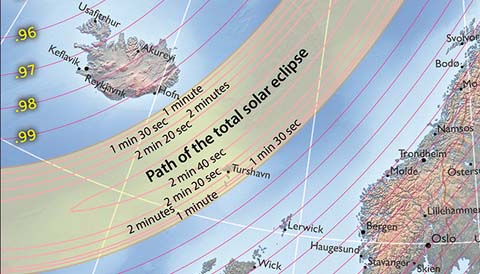As the countdown for Friday's total solar eclipse nears zero, "umbraphiles" from around the world are flocking to remote parts of the far north in the hope of finding clear skies.
Total eclipses of the Sun occur about every 1½ years on average, and there are roughly a thousand people worldwide who make a point to see as many of them as they reasonably can.
"Reasonably" is the key here. The one in February 1998 was easy, as the Moon's shadow passed right over Aruba and drew an armada of cruise ships to the Caribbean (rum punch, anyone?). The 2016 eclipse will take umbraphiles to balmy Indonesian seas. And looking ahead, in August 2017, everyone in the continental U.S. will be no more than a 2-hour flight and quick car rental away from an umbral path that runs coast to coast from Oregon to the Carolinas.
But the total eclipse on Friday is drawing a special breed of "umbraphile." This one misses all the easy-to-reach destinations. Instead, the path of totality sweeps northeastward over the Arctic Ocean, making its only landfall on the remote Faroe Islands and the Svalbard archipelago — places some of you, I'll bet, have never heard of, let alone considered visiting.

Michael Zeiler
The challenge is more than just getting to these remote islands, which are lovely (in a stark kind of way) but have limited resources to accommodate throngs of tourists. Here's the additional rub: at this time of year the prospects for clear skies are not particularly favorable anywhere along the track.
As Jay Anderson, a specialist in forecasting weather conditions for eclipses, explains, "The North Atlantic is a cloudy and stormy place, no more so than in March, being subject to three major cloud-making influences: a humid, ice-free ocean surface; a cold winter/spring atmosphere that saturates easily; and a location near the main track of low-pressure systems that leave the North American continent and venture across the North Atlantic and Barents and Greenland Seas."
So what's an eclipse-chaser to do? You start planning long in advance, that's what. Companies that specialize in eclipse-related travel have been advertising tours for at least a year, and many sold out quickly. Some of these are land-based, with lodging provided in Tórshavn, the capital and largest city in the Faroes, or in Spitsbergen, Svalbard's largest and only permanently populated island. Scores of private homes have been turned into temporary B&Bs.
Other travelers have booked passage on ships coming from Copenhagen, the British Isles, and elsewhere. At least these folks will have a modicum of mobility to "run" toward clear skies if the weather on Friday proves partly cloudy.
Totality From On High
But for the ultimate in high-probability eclipse viewing, nothing beats being on an airplane. This approach only works if the eclipsed Sun is relatively close to the horizon (as it will be), and good views can only be had from one side of the plane. Quite a few airborne intercepts are planned — the skies over the Arctic Ocean will be a little more crowded than usual. Air Events, a German travel company, will dispatch three Boeing 737s. (I'll be on one of these!) Other private charters abound.
But the crowded airspace favors the well-prepared: eclipse flights that were to depart from Paris and Brussels have been cancelled. (Those passengers will be scrambling for seats — perhaps they'll be tempted to head to Murmansk, Russia, where an eclipse flight is said to be available for the rock-bottom price of 10,000 rubles, or about $165!)
Some enterprising eclipse-chasers have even found a commercial flight — Icelandair (FI) 450 — that will serendipitously pass through the lunar umbra while en route from Reykjavik to London. In fact, an airline representative says seeing totality will not be left to chance: "The flight plan for FI 450 Friday is dedicated to being in the right spot at the right time, and to turn the aircraft so that the passengers can enjoy the eclipse."
Partial Views
Meanwhile, back on the ground, all of Europe (plus northern Africa and western Asia) will have to settle for a partial eclipse, which in some places will be quite dramatic. Cartographer Michael Zeiler has put a new spin on "how deep is deep": he's created a map that equates the strength of light from the partly covered solar disk to how much sunlight you'd experience on, say, Mars or Jupiter.
Finally, those of you stuck in the Americas are not completely out of luck, though you'll need to be an early riser. A handful of sites are intending to webcast views of the eclipse, starting around 4 a.m. Eastern Time:
- Norwegian broadcaster NRK (from Longyearbyen, Svalbard)
- Gianluca Masi's Virtual Telescope (Italy)
- Carles Schnabel from Sant Esteve Sesrovires (Catalonia/Spain) (backup site)
 1
1
Comments
Graham-Wolf
March 19, 2015 at 11:03 pm
Good luck for tomorrow's Solar Eclipse, you "Northerners".
My British collagues will be "busy as".
We won't see it from NZ at all, but those in Scandinavia, and northern UK will certainly get a decent "partial". From London even, there will be a decent partial. Icelanders are arguably as close on land to the actual totality path as anyone out there.
Got a spare 747 Charter-plane and a cheap pilot? Concorde once "supersoniced" it's way across the Atlantic at Mach 2+, and got artificially (was it 73minutes) of extended totality. Ahhhh.... those were the days! Will the ISS get in on the action, or is it's orbit unfavourable?
Very lucky astronauts if it IS!
Graham W. Wolf:- Lower Hutt, New Zealand.
You must be logged in to post a comment.
You must be logged in to post a comment.